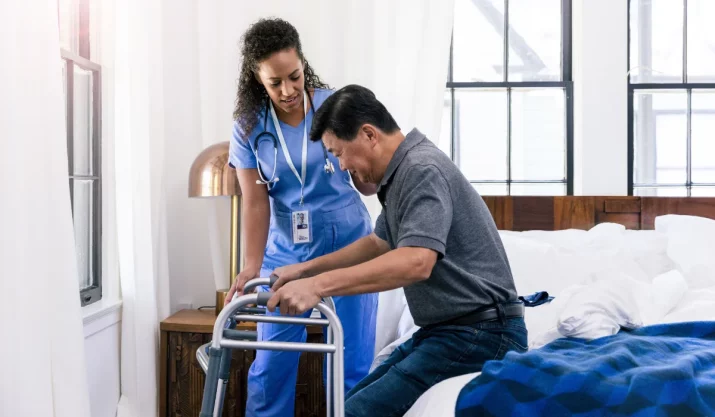Common Age-Related Eye Problems

Table of Contents
In your early twenties, you may have never given a second thought to your vision.
However, as you age, you may experience some common age-related eye problems like cataracts, glaucoma, or macular degeneration.
Keep reading to learn more about each of these conditions and what you can do to protect your eyesight.
Key Takeaways
- A few of the most common eye conditions are glaucoma, macular degeneration, and cataracts.
- While some eye problems are not preventable, there are steps you can take to preserve your eye health.
- Eat a healthy diet, lower your blood pressure, and clean your contact lenses.
Why Does Eye Health Decline as We Age?
As we age, our bodies undergo a number of changes. Our skin becomes less elastic, our bones grow weaker, and our joints become stiffer. Unfortunately, age also takes a toll on our eyesight. Common age-related eye problems include cataracts, glaucoma, and macular degeneration. All of these conditions can cause significant vision loss.
So why exactly does eye health decline as we age?
One factor is simply the wear and tear that comes with time. Just as our muscles and joints deteriorate with age, so too do the tissues of the eye. For example, the proteins and fluids that give our eyes structure break down, the lens that allows us to focus on objects becomes less flexible, and we produce less tears to keep our eyes lubricated.
Exposure to ultraviolet (UV) light and environmental toxins is responsible for much of the damage to the eye over time.
Common Age-Related Eye Problems
Our bodies go through various changes as we age. This includes changes to our eyes that can lead to a variety of problems. Here are some common age-related eye problems and their symptoms.
Cataracts
A cataract is a cloudy or opaque area in the lens of the eye that affects vision. Most cataracts are age-related and are more common in older people. Cataracts can also be caused by injuries, certain diseases, and prolonged exposure to UV light.
In most cases, cataracts are treatable with surgery. During cataract surgery, the clouded lens is removed and replaced with an artificial lens.
Cataracts usually develop slowly and painlessly and may not cause any symptoms at first. However, as they progress, they can cause blurred or dimmed vision, increased sensitivity to light, trouble seeing at night, and faded or yellowed colors.
If you think you may have a cataract, it’s important to see an eye doctor for a diagnosis. Early diagnosis and treatment can help preserve your vision.
Age-Related Macular Degeneration
Age-related macular degeneration (AMD) is a condition that causes damage to the macula, a small area in the center of the retina (the back of the eye) that is responsible for sharp central vision.
AMD is a leading cause of blindness in older adults and is most common in those aged 60 and over. While vision loss from AMD can occur gradually, it can also happen suddenly.
There are two main types of AMD: dry and wet. Dry AMD occurs when the macula becomes thin and begins to break down. Wet AMD occurs when new blood vessels grow under the retina and leak fluid or blood, which can cause vision loss.
While there is no cure for AMD, there are treatments available that can help to slow down its progression and preserve vision. Early diagnosis and treatment are essential.
Diabetic Retinopathy
Diabetic retinopathy is a condition that affects the retina and is caused by high blood sugar levels (diabetes) damaging the blood vessels in the retina. The retina is the part of the eye that receives light and sends visual signals to the brain.
Diabetic retinopathy is more common in older people because as we age, our blood vessels become less flexible and are more easily damaged. Over time, high blood sugar levels can cause these blood vessels to leak or even close off completely, preventing oxygen and nutrients from reaching the retina. This can lead to vision problems, including blindness.
Diabetic retinopathy is a serious condition, but it can be largely prevented or slowed by maintaining target blood sugar levels.
Glaucoma
Glaucoma is an eye condition that most often occurs in older adults. It is caused by an increase in pressure inside the eye, which damages the optic nerve. In some cases, this damage can lead to vision loss. Glaucoma typically develops slowly, and many people do not experience any symptoms in the early stages of the disease.
However, as it progresses, glaucoma can cause changes in vision, such as decreased peripheral vision or difficulty seeing at night. If left untreated, glaucoma can eventually cause blindness or total visual impairment. In fact, it’s a leading cause of vision loss. Treatment options are medications (eye drops) or surgery to control the disease and prevent vision loss, but there is currently no cure for glaucoma.
Retinal Detachment
The retina is a thin layer of tissue at the back of the eye that senses light and sends images to the brain.
When the retina detaches from the back of the eye, it’s no longer able to sense light or send messages to the brain. This can cause blindness. Retinal detachment is most common in older people because it’s more likely to happen as the eye ages and the vitreous (jelly-like substance) inside the eye shrinks. When the vitreous shrinks, it pulls at the retina and may even tear it. Sometimes, a retinal detachment occurs when fluid gets behind the retina and pushes it away from the back surface of the eye.
There are several other risk factors for retinal detachment, including family history, previous eye injuries, and certain medical conditions.
Dry Eye Syndrome
Dry eye syndrome occurs when the eyes do not produce enough tears or when the tears evaporate too quickly. This can lead to inflammation, irritation, and redness of the eyes.
Dry eye syndrome is more common in older people for a number of reasons. As we age, our bodies produce fewer tears. Additionally, conditions such as diabetes and arthritis can lead to dry eye syndrome. Older people are also more likely to take medications that can cause dryness of the eyes.
Trichiasis
Trichiasis is the condition where eyelashes grow inwards and irritate the eye. It can cause pain, tearing, redness, and inflammation. In severe cases, it can lead to corneal ulcers and even blindness.
Trichiasis is more common in older people because as we age, our eyelashes become shorter and more brittle. This makes them more likely to turn inwards and grow toward the eye.
If you have trichiasis, it’s important to see an eye doctor to determine the best treatment for you. In some cases, surgery may be necessary to remove the offending eyelashes. With treatment, trichiasis can be controlled, and serious complications can be avoided.
Eyestrain
Eyestrain is a type of pain that affects the muscles and tendons in your eyes. It’s more common in older people because the muscles and tendons around your eyes become less elastic as you age.
Eyestrain can also be caused by staring at a computer screen or other digital device for long periods of time.
If you have eyestrain, you may notice symptoms like headaches, dry eyes, blurred vision, or neck and shoulder pain. While eyestrain is usually not serious, it can be painful and disruptive.
Blepharitis
Blepharitis is a condition that affects the eyelids, causing them to become red, itchy, and inflamed. It is a common condition, and it is more likely to occur in older adults.
There are several possible causes of blepharitis, including bacterial infection, allergies, and skin conditions such as seborrheic dermatitis.
Blepharitis is relatively common, but it can be uncomfortable and frustrating. Fortunately, there are effective treatments available for those who suffer from this condition. In most cases, blepharitis can be treated with over-the-counter medications or home remedies. However, some cases may require treatment from a healthcare provider.
Floaters
Floaters are tiny clumps of gel or cells that float in the vitreous—the clear gel that fills the inside of your eye. When you look at a bright or light-colored scene, such as a white wall or blue sky, you may see the floaters. Floaters usually appear when you are looking at something bright because they cast shadows on your retina.
Most people have floaters but usually don’t notice them until they become more numerous. This can happen as you age and the vitreous gel begins to shrink and clump together.
In some cases, floaters can be a sign of serious problems with your eyes, such as retinal detachment or vitreous hemorrhage. If you have new floaters or flashes of light in your vision, you should see an eye doctor right away to figure out if you have any risk factors or are in the early stages of another type of eye disease.
What Can You Do To Protect Your Vision?
The good news is that you can do a few things to maintain good vision.
- Wear sunglasses when you’re outdoors. UV rays from the sun can damage your eyes and lead to cataracts. Look for sunglasses that are labeled either “100% (or 99%) UV Protection,” or “UV400.”.
- Wear protective eyewear when you’re playing sports or working around the house. A baseball flying off a bat or a wood chip can injure your eyes. Wearing safety glasses or goggles will help protect them.
- Quit smoking. Smoking increases your risk for age-related macular degeneration, cataracts, and optic nerve damage. If you smoke, the best thing you can do for your vision is to quit.
- Eat healthy foods. Eating a diet rich in fruits, vegetables, and omega-3 fatty acids may help reduce your risk for age-related macular degeneration and cataracts. Some specific foods that are good for your eyes include spinach, kale, fish, nuts, and oranges.
- Get regular eye exams. As you reach age 65, it’s important to have your eyes checked at least once every 1 to 2 years with a dilated eye exam. Early detection is key to avoiding many common eye problems.
The Bottom Line
It’s important to be proactive about your eye health and get eye exams as recommended by the American Academy of Ophthalmology. The earlier any potential problems are caught, the better chance you have of preserving your vision for years to come.
If you or a loved one is experiencing any of the symptoms listed in this post, please don’t hesitate to reach out for help from a licensed eyecare professional, such as an optometrist or ophthalmologist.








